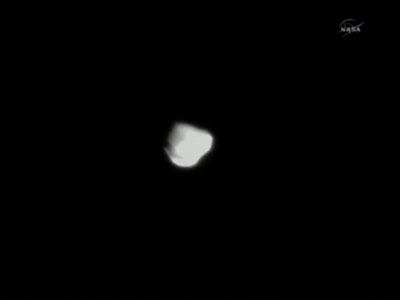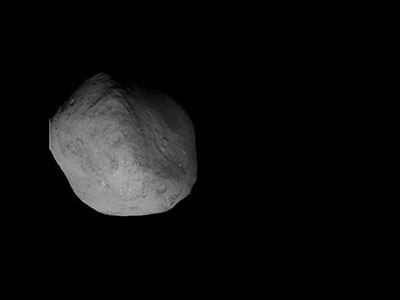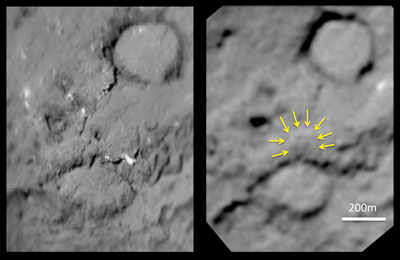|
|

|
 |
| Forum: | Satellites - Robotic Probes |
| Topic: | NASA's Stardust-NExT to Comet Temple 1 |
|
| Want to register?
|
If you have previously registered, but forgotten your password, click here.
| | Robert Pearlman | Comet Hunter's First Images on the GroundMission controllers at NASA's Jet Propulsion Laboratory have begun receiving the first of 72 anticipated images of comet Tempel 1 taken by NASA's Stardust spacecraft. 
Credit: NASA TVAbove: NASA's Stardust-NExT mission transmitted the first image it took during its approach to comet Tempel 1 at 8:35 p.m. PST on Feb. 14, 2011, from a distance of approximately 2,462 kilometers (1,530 miles). The first six, most distant approach images are available on NASA's website. Additional images, including those from closest approach, are being downlinked in chronological order and will be available later in the day. Mission managers had originally planned to receive the images taken during Stardust-NExT's closest approach first. "We sent the commands that we had planned, anticipating the middle five images of the 72 image sequence would be played back," explained Chris Jones, JPL's associate director for flight projects and mission success. "What we got instead, we went to the top of the stack and the first picture that we received was the first image." "It will take about six hours at the playback rate to get us to those five images," said Jones. A news conference previously planned for 10 a.m. PST (1 p.m. EST) will be held later in the day, to allow scientists more time to analyze the data and images. | | Scott | More images are coming in now. Very cool. | | Robert Pearlman | NASA release NASA Releases Images Of Man-Made Crater On CometNASA's Stardust spacecraft returned new images of a comet showing a scar resulting from the 2005 Deep Impact mission. The images also showed the comet has a fragile and weak nucleus. The spacecraft made its closest approach to comet Tempel 1 on Monday, Feb. 14, at 8:40 p.m. PST at a distance of approximately 111 miles. Stardust took 72 high-resolution images of the comet. It also accumulated 468 kilobytes of data about the dust in its coma, the cloud that is a comet's atmosphere. The craft is on its second mission of exploration called Stardust-NExT, having completed its prime mission collecting cometary particles and returning them to Earth in 2006. The Stardust-NExT mission met its goals which included observing surface features that changed in areas previously seen during the 2005 Deep Impact mission; imaging new terrain; and viewing the crater generated when the 2005 mission propelled an impactor at the comet. "This mission is 100 percent successful," said Joe Veverka, Stardust-NExT principal investigator of Cornell University, Ithaca, N.Y. "We saw a lot of new things that we didn't expect, and we'll be working hard to figure out what Tempel 1 is trying to tell us." Several of the images provide tantalizing clues to the result of the Deep Impact mission's collision with Tempel 1. 
Credit: NASA/JPL-Caltech/Cornell"We see a crater with a small mound in the center, and it appears that some of the ejecta went up and came right back down," said Pete Schultz of Brown University, Providence, R.I. "This tells us this cometary nucleus is fragile and weak based on how subdued the crater is we see today." Engineering telemetry downlinked after closest approach indicates the spacecraft flew through waves of disintegrating cometary particles including a dozen impacts that penetrated more than one layer of its protective shielding. "The data indicate Stardust went through something similar to a B-17 bomber flying through flak in World War II," said Don Brownlee, Stardust-NExT co-investigator from the University of Washington in Seattle. "Instead of having a little stream of uniform particles coming out, they apparently came out in chunks and crumbled." While the Valentine's Day night encounter of Tempel 1 is complete, the spacecraft will continue to look at its latest cometary obsession from afar. "This spacecraft has logged over 3.5 billion miles since launch, and while its last close encounter is complete, its mission of discovery is not," said Tim Larson, Stardust-NExT project manager at JPL. "We'll continue imaging the comet as long as the science team can gain useful information, and then Stardust will get its well-deserved rest." | | Robert Pearlman | NASA release NASA's Venerable Comet Hunter Wraps up MissionAt 33 minutes after 4 p.m. PDT March 24, 2011, NASA's Stardust spacecraft finished its last transmission to Earth. The transmission came on the heels of the venerable spacecraft's final rocket burn, which was designed to provide insight into how much fuel remained aboard after its encounter with comet Tempel 1 in February. "Stardust has been teaching us about our solar system since it was launched in 1999," said Stardust-NExT project manager Tim Larson from NASA's Jet Propulsion Laboratory in Pasadena, Calif. "It makes sense that its very last moments would be providing us with data we can use to plan deep space mission operations in the future." The burn to depletion maneuver was designed to fire Stardust's rockets until insufficient fuel remains to continue, all the while downlinking data on the burn to Earth some 312 million kilometers (194 million miles) away. Mission personnel will compare the amount of fuel consumed in the burn with the amount they anticipated would be burned based on their fuel consumption models. Fuel consumption models are necessary because no one has invented a reliable fuel gauge for spacecraft when in the weightless environment of space flight. Until that day arrives, mission planners can approximate fuel usage by looking at the history of the vehicle's flight and how many times and for how long its rocket motors have fired. Mission personnel watched the final data from the burn come down at JPL's Space Flight Operations Facility and at the Stardust-NExT mission support center at Lockheed Martin Space Systems in Denver. "Stardust motors burned for 146 seconds," said Allan Cheuvront, Lockheed Martin Space Systems Company program manager for Stardust-NExT. "We'll crunch the numbers and see how close the reality matches up with our projections. That will be a great data set to have in our back pocket when we plan for future missions." The Stardust team performed the final burn to depletion because NASA's most senior comet hunter is a spacecraft literally running on fumes. Launched on Feb. 7, 1999, Stardust had completed its prime mission back in January 2006. By that time, Stardust had already flown past an asteroid (Annefrank), flown halfway out to Jupiter to collect particle samples from the coma of a comet, Wild 2, and returned to fly by Earth to drop off a sample return capsule eagerly awaited by comet scientists. NASA then re-tasked the spacecraft to perform a bonus mission to fly past comet Tempel 1 to collect images and other scientific data. Stardust has traveled about 21 million kilometers (13 million miles) in its journey about the sun in the few weeks since the Valentine's day comet Tempel 1 flyby, making the grand total from launch to its final rocket burn about 5.69 billion kilometers (3.54 billion miles). With all that mileage logged, the Stardust team knew the end was near. Now, with its fuel tank empty and its final messages transmitted, history's most traveled comet hunter will move from NASA's active mission roster to retired. "This kind of feels like the end of one of those old Western movies where you watch the hero ride his horse towards the distant setting sun – and then the credits begin to roll," said Larson. "Only there's no setting sun in space." Stardust-NExT was a low-cost mission to expand the investigation of comet Tempel 1 initiated by NASA's Deep Impact spacecraft. JPL, a division of the California Institute of Technology in Pasadena, managed the Stardust-NExT project for the NASA Science Mission Directorate, Washington, D.C., which was part of the Discovery Program managed by NASA's Marshall Space Flight Center in Huntsville, Ala. Joe Veverka of Cornell University, Ithaca, N.Y., was the mission's principal investigator. Lockheed Martin Space Systems, Denver, built the spacecraft and managed day-to-day mission operations. | | Blackarrow | "Well done, thou good and faithful servant." | |




